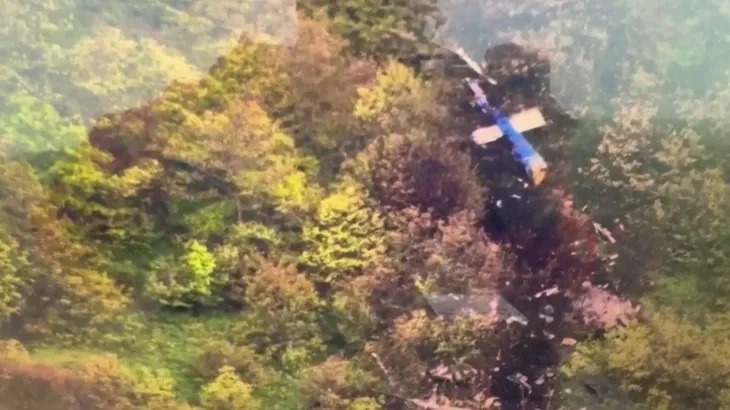You can now listen to Antigua News articles!

by Mick the Ram
It has been confirmed that the president of Iran, Ebrahim Raisi, has died in a helicopter crash in the north of the country, close to its border with Azerbaijan.
The burnt out wreckage was found on side of steep mountain, together with the bodies of the passengers, which along with the president included the Foreign Minister, Hossein Amir-Abdollahian, and up to 6 others.
It was initially reported that the helicopter had made a rough landing in dense fog, in a remote part of north-western Iran as it returned from a visit with Azerbaijani president Ilham Aliyev, but it appears now that the aircraft crashed.
Mr Raisi, who was 63-years-old, was tipped as a potential successor to Iran’s Supreme Leader Ayatollah Ali Khamenei.
Following his death, it falls to the vice-president, Mohammad Mokhber to run the affairs of the country until an election is held to appoint a new president, within a maximum of 50 days.
Iranian news outlet Tasnim, which is affiliated to the country’s Islamic Revolution Guards Corps, is reporting that President Ebrahim Raisi’s funeral will be held tomorrow (21 May) in Tabriz, the city he was travelling to when his helicopter came down.
Turkish drone spots helicopter
It was a drone sent by Turkey to assist in the search that actually identified a source of heat on the mountain side. Some footage from the Bayraktar Akinci high-altitude long-range drone was reported to show an aerial view of a landscape at night and a dark blotch on what appears to be a hillside.
From this they were able to direct rescuers to an exact location, who confirmed the news that the helicopter had crashed and the main body had been completely burnt out.
Other passengers named
The names of some of those killed in the helicopter crash besides Iran’s President Ebrahim Raisi and Foreign Minister Hossein Amir-Abdollahian have now been released.
Ayatollah Mohammad Ali Al-e Hashem, the imam for Friday prayers in the city of Tabriz, General Malek Rahmati, the governor of the Iranian province of East Azerbaijan, and the commander of the president’s protection unit, Sardar Seyed Mehdi Mousavi, were tragically killed in Sunday’s crash.
A number of bodyguards and helicopter crew who have not yet been named, also perished.
Bodies badly burnt
A military official said they were: “in the process of transferring the bodies of the martyrs to Tabriz” which is in Iran’s north west.
They confirmed that identification of bodies was difficult as some were very badly burned and all will be taken to a forensics department, before being released back for individual funerals.
The Iranian news outlet, Tasnim, which is affiliated to the country’s Islamic Revolution Guards Corps, is reporting that President Raisi’s funeral will be held tomorrow (21 May) in Tabriz.
Poor record with air transport
The cause of the helicopter crash is not yet known, but Iran has a poor air transport safety record and some of the reason for that is down to decades of US sanctions, which have severely weakened the country’s aerial fleet.
The crashed helicopter was a Bell 212 and that model was made in the US and could not have been sold to Iran since the 1979 revolution. In the years since then, previous ministers of defence and transport, as well as commanders of Iran’s ground and air armed forces, have died in plane or helicopter crashes.
Reliant upon dated aircraft
When reformers led Iran’s government, they aimed to modernise the country’s fleet of aircraft by negotiating a deal with the West that would see sanctions lifted in return for limiting Iran’s sensitive nuclear activities and allowing in international inspectors.
However, those efforts stalled when President Donald Trump withdrew from the deal and reimposed sanctions. Reformers were subsequently opposed and mocked by hardliners, who insisted that Iran could rely on its own domestic industries and foreign allies to improve aviation safety.
Condolences from Russia and China
On hearing the news, Russian President Vladimir Putin offered his condolences, describing President Raisi as a “true friend of Russia” and an “outstanding politician”.
Iran has been seen as a key military ally of Moscow since it launched its full-scale invasion of Ukraine, in 2022.
China’s President Xi Jingping has described Raisi as a “good friend” to the Chinese people, and his death is a “great loss to the Iranian people”.
China is Iran’s largest trade partner and a main buyer of its sanctioned oil.
Other countries send messages of support
A number of other countries have expressed their condolences, with a national day of mourning announced by Pakistan Prime Minister, Shehbaz Sharif.
India’s Prime Minister Narendra Modi said he was “deeply saddened and shocked” by the deaths; whilst Turkey’s President Recep Tayyip Erdogan said his government was “in full contact and co-ordination with the Iranian authorities” and was ready to “provide any necessary support if needed”.
Raisi was on brink of climbing into top position
Ebrahim Raisi stood close to the pinnacle of power in the Islamic Republic and was widely tipped to rise to its very top and replace Supreme leader, Ayatollah Ali Khamenei, whose own health has long been the focus of intense interest.
Nevertheless, whoever assumes Raisi’s mantle inherits a forbidding agenda and limited levers of power, as ultimate decision-making authority in the Islamic Republic lies with the Supreme Leader.
Who is Mohammad Mokhber?
Initially, that will be former first vice-president Mohammad Mokhber. He takes immediate control as interim president for the next 50 days, at least.
Mokhber was elected as first vice-president after the 2021 elections that saw Raisi come to power.
The 68-year-old top diplomat is known for being close to Supreme Leader Ali Khamenei and it was he who visited Moscow in October, when Iran agreed to supply surface-to-surface missiles and more drones to Russia’s military.
Back in 2010, the European Union included Mokhber on a list of individuals it was sanctioning for alleged involvement in “nuclear or ballistic missile activities”, although he was removed two years later.
Five days of mourning in Iran
Iran’s supreme leader Ayatollah Ali Khamenei has issued an official statement announcing five days of public mourning for President Raisi.












0 Comments